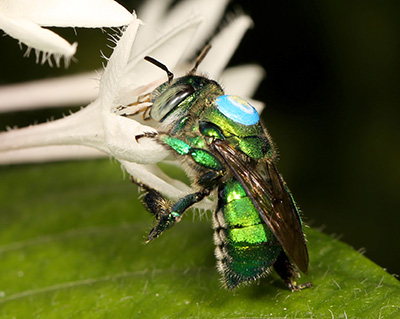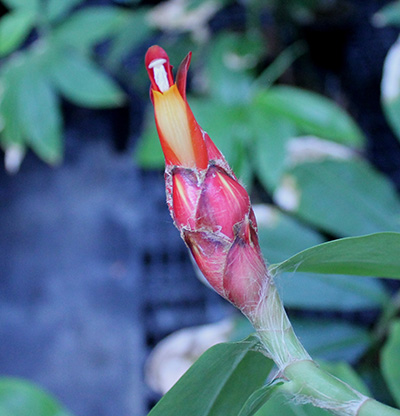A huge number of plant species underlies the remarkable biological diversity found in the tropical forests of Central and South America. Costa Rica alone has more than 12,000 species of plants. Yet biologists are not quite sure what drove the astounding diversification of plants in this region.
Kathleen Kay, an associate professor of ecology and evolutionary biology at UC Santa Cruz, studies an especially diverse group of tropical plants called spiral gingers. With a new $2 million grant from the National Science Foundation (NSF) Dimensions of Biodiversity program, Kay is leading a collaborative research effort using spiral gingers to investigate the evolutionary origins of tropical biodiversity.
Spiral gingers originated in Africa and dispersed to the Americas about 1.5 to 7 million years ago. In the New World, the initial colonizers evolved into more than 60 different species, one of the fastest examples of "adaptive radiation" (diversification into new forms) in plants.
Kay's team, which includes investigators at five universities, will test different explanations for why new species evolved so rapidly in the tropics. One hypothesis is that species adapted to the stable year-round climate of the tropics are unable to tolerate a wide range of conditions, leading to geographic isolation and the evolution of new species separated by varied topography. Alternatively, diversification may be driven by interactions between plants and other organisms, such as pollinators and herbivores, which may vary from place to place.
Spiral gingers are found mostly in the forests of Costa Rica, Panama, western Colombia, and Ecuador, but they occur in a wide range of environments and soil types. "Some grow right on the beach in salt spray, and others grow deep in the forest, where it is so dark you can't even measure the light with a standard light meter," Kay said. "And some grow way up in the mountains at elevations of 5,000 feet."
Spiral gingers also interact with many different animals, including different species of hummingbirds and orchid bees that pollinate their flowers. There are specialized beetles that feed on the young leaves of spiral gingers, and ants that provide protection from herbivores in exchange for nectar. The flowers of spiral gingers come in different colors and shapes to attract different types of pollinators. Bee-pollinated flowers have stripes on their petals and a lip where bees can land, whereas hummingbird-pollinated gingers have bright-red tube-shaped flowers full of nectar.
"Two species can occur in the same place but with different flower shapes for attracting different pollinators," Kay said.
Forest reserves
To understand which types of interactions are more important in driving the evolution of new species, Kay and her collaborators will combine several different approaches, including observational studies, field experiments, and genetic mapping. They plan to start field work in forest reserves in Panama and Costa Rica in April 2018.
Observational studies will help the researchers determine which characteristics of the plants are important for adapting to physical conditions, such as soil type or the amount of sunlight, and which are important for interactions with other organisms. Experiments in the field and in greenhouses will investigate how well different species of spiral gingers tolerate changes in environmental conditions or interactions with different organisms. Researchers will also do cross-pollination experiments and test the performance of hybrids. Intensive genetic studies will enable the researchers to identify genetic markers for specific traits and to reconstruct the evolutionary history of different species of spiral gingers.
The study will help guide conservation efforts by giving scientists a better understanding of the biology of tropical plants and how they are adapted to their environments. It will also provide valuable opportunities for students, with at least 50 undergraduates and several graduate students expected to take part in the study.
The team will contribute to field courses that regularly visit their field research sites, including Spanish-language courses that attract primarily Latin American students. Kay has been involved in these courses at field sites in Costa Rica and Panama for the past 12 years. The research team is also dedicated to increasing local capacity in biodiversity science by hiring and training local field assistants at each field site.
"I have hired people straight out of high school who have no experience in the forest, but live right there, and they have gone on to have really nice jobs in the field of biology," Kay said. "They come to appreciate the tropical forest as their backyard, in a way they wouldn't really get without these opportunities."
In addition to Kay, the other principal investigators for this project are Dena Grossenbacher at Cal Poly San Luis Obispo, an expert in ecological niche modeling and phylogeny; Santiago Ramírez at UC Davis, an orchid bee expert; Jennifer Funk at Chapman University, an ecophysiologist; and Carlos Garcia-Robledo at the University of Connecticut, an expert on plant-herbivore interactions. Douglas W. Schemske, professor emeritus of plant biology at Michigan State University, who did pioneering research on spiral gingers and was Kay's Ph.D. adviser, will be involved with some of the experimental and writing aspects of the project.





